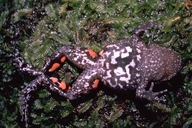|
Adelotus brevis (Günther, 1863)
Tusked Frog | family: Myobatrachidae subfamily: Limnodynastinae genus: Adelotus |
 © 2002 Jean-Marc Hero (1 of 7) |
|
|
|
Description This frog is reasonably distinguishable from all other Australian frogs by the combination of the orange or red patches in the groin and on the thigh and the presence of the black and white belly. Pseudophryne toadlets have the black and white belly, but not the patches. Uperoleia toadlets have the groin and thigh patches, but not the black and white belly. Distribution and Habitat Country distribution from AmphibiaWeb's database: Australia
Disjunct population in the Clarke Range (mid-eastern Queensland) then from Shoalwater Bay (mid-eastern Queensland) south along the coast to Moss Vale (mid-eastern New South Wales) and inland to Blackdown Tableland and Carnarvon Gorge. The extent of occurrence of the species is approximately 480700 km2. This frog remains reasonably common throughout its entire range and is still so today in the lowland areas. In the mid to late 1970s however, it disappeared from the New England Tablelands for reasons that are still not clear. It is presumed that land clearing, habitat alteration, loss of water quality, spread of exotic fish species (eg, plague minnow) and disease and all had some part to play in this decline. The only populations recorded on the Tablelands in recent years have been seen in the Nowendoc area, at the very southern end of the Tablelands. For this reason, the New England Tablelands population of this frog has recently been listed as an Endangered Population under the Threatened Species Conservation Act.
Habitat Life History, Abundance, Activity, and Special Behaviors The eggs are unpigmented and laid into a foam nest that is concealed underneath vegetation and/or debris. An adult male has been observed dragging eggs on to the egg mass to conceal it, probably a first for this type of parental care in Australian frogs. The eggs hatch after several days and the tadpoles take an average of 2-3 months to reach metamorphosis. The tadpoles are an unremarkable brown colour and grow up to around 30mm in size. Development is usually complete within 71 days. Trends and Threats
Conservation Measures
References
Barker, J., Grigg, G. C., and Tyler, M. J. (1995). A Field Guide to Australian Frogs. Surrey Beatty and Sons, New South Wales. Czechura, G.V. (1986). ''Distant exiles: Frogs and reptiles recorded from Kroombit Tops SEQ.'' Queensland Naturalist, 26(1-4), 61-67. Hines, H., Mahony, M. and McDonald, K. (1999). ''An assessment of frog declines in wet subtropical Australia.'' Declines and Disappearances of Australian Frogs. A. Campbell, eds., Environment Australia, Canberra, 44-63. Hodgkison, S.C. and Hero, J.-M. (2001). ''Daily behaviour and microhabitat use of the Waterfall Frog, Litoria nannotis in Tully Gorge, eastern Australia.'' Journal of Herpetology, 35(1), 166-120. Katsikaros, K. and Shine, R. (1997). ''Sexual dimorphism in the Tusked Frog, Adelotus brevis (Anura: Myobatrachidae) the roles of natural and sexual selection.'' Biological Journal of the Linnean Society, 60, 39-51. Originally submitted by: Jean-Marc Hero et. al. (first posted 2002-04-05) Edited by: Ambika Sopory, Jean-Marc Hero, F. Lemckert (2008-09-16) Species Account Citation: AmphibiaWeb 2008 Adelotus brevis: Tusked Frog <https://amphibiaweb.org/species/3484> University of California, Berkeley, CA, USA. Accessed Jul 26, 2024.
Feedback or comments about this page.
Citation: AmphibiaWeb. 2024. <https://amphibiaweb.org> University of California, Berkeley, CA, USA. Accessed 26 Jul 2024. AmphibiaWeb's policy on data use. |



 Map of Life
Map of Life